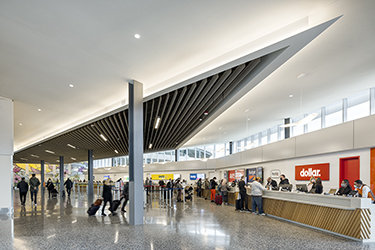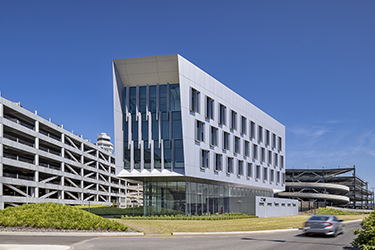|
Subscribe / Renew |
|
|
Contact Us |
|
| ► Subscribe to our Free Weekly Newsletter | |
| home | Welcome, sign in or click here to subscribe. | login |
Environment
| |
 |
April 25, 2024
Hiding in Plain Sight: Sustainability and resilience beyond the terminal
Integrus

Robbins
|
In the rush to and from an airport, travelers and those picking up or dropping off passengers likely don’t pay much attention to the physical nature of the parking, ride share and rental car facilities they pass through. At Portland International Airport, as part of the transformative, multi-phase PDX Next project, relocation and upgrades of these service spaces were given elevated consideration by the Port of Portland (the Port).
The initial project brief grew to incorporate adding airport offices and an operations center built to withstand significant seismic events and maintain critical functions. This created unusual design and engineering challenges for the progressive design-build team selected. Referred to as PACR (Parking Additions and Consolidated Rental Car Facility), the $325 million building and structure with a cumbersome name presents a standard-setting example of advancing exceptional sustainable and resilient design where least expected. How many people walk by or utilize services each day — not realizing the underlying importance of this sleek presence?
DESIGNING FOR DISPARATE SERVICES
The Port strives to provide an exceptional passenger experience at PDX, consistently ranked ‘the best airport in the U.S.. The unprecedented combination of long-term parking, rental car and critical airport operations adjacent to the terminal is a triumph in improving traveler ease and satisfaction, optimized for environmental efficiency with a backdrop of resilient infrastructure able to withstand natural disasters and meet future challenges. What does it take to design for a combination of disparate passenger services and critical airport functions, in an earthquake prone region, while keeping efficiency and traveler satisfaction in mind?
PUTTING PASSENGER EXPERIENCE FIRST
Improving passenger access and parking is a priority for most airports, and the Port saw PACR as an opportunity to take it further. Not only to expand its reputation for putting passenger experience and convenience first, but also to build in more sustainability and resilience in its operational facilities. Previously, several rental car facilities were offsite.
Major expansion of the on-site long-term parking and rental car facilities in the form of a multi-level parking structure a walkable (or moving walkway) distance through an underground tunnel makes it quick and easy for people to reach their cars or rental car services without exposure to the elements. The bright passageway is enlivened with art by regional artists. The 1.7 million square foot PACR complex includes six floors of parking with 2,200 long-term parking stalls, ADA parking spots and electric-vehicle charging stations.
The neighboring four-story building includes a first-floor rental car lobby encompassing 11 rental car partners. It atypically features an open and welcoming layout, with warm wood panels, natural lighting and artwork. Eliminating the need for shuttle buses to offsite parking and rental car locations in the airport corridor greatly streamlines overall airport campus circulation, both reducing the volume of cars and related Co2 emissions. It also removes a primary point of aggravation travelers face at an airport.
The project also simplified the parking and rental facility exit and fee payment process. Of note, the structure represents the first Portland-metro area use of carbon sequestering CarbonCure concrete. Given the large volume of concrete used, this significantly reduces the structure’s overall carbon footprint and contributed to achieving LEED Gold certification.
RESILIENT DESIGN FOR CRITICAL AIRPORT FUNCTIONS
The upper floors of the 95,000 square feet of office space house critical airport functions. Located in an earthquake zone, the building necessarily incorporates resilient design strategies to ensure airport operations remain functional following a 9.0 Cascadian earthquake event. Accordingly, it is also designated as one of several statewide natural disaster emergency coordination stations.
Assembling the team of experts required to design a resilient essential services building was aided by the progressive design-build delivery model decision-making framework leveraging the experience and insights of all partners and stakeholders from the start. This was especially important as the Port wanted to deliver a design solution with minimal operational disruption. Project partners include JE Dunn, PAE, KPFF, Mayer/Reed, and numerous small businesses.
Regional realities unique to the airport’s geographic location were considered in achieving this ambitious goal.
Portland International Airport is located in the Cascadia Subduction Zone, a 1,000 km megathrust fault line stretching from Canada to California, with subduction zones that have produced the largest earthquakes on record. It isn’t a matter of if, but when, the next large magnitude earthquake occurs here. The reality of highly liquefiable site area soil added technical complexity and dictated the need for resilience standards much higher than other geographies. PACR features a hybrid steel frame structure with composite concrete decking. Concrete is one of the largest producers of greenhouse gases contributing to global warming. The Port is progressive in its commitment to protecting the environment and promoting sustainability, in this case advancing the use of carbon sequestering CarbonCure concrete.
A FRAMEWORK FOR COLLABORATION
An endeavor of this magnitude with so many stakeholders could easily have devolved into competing agendas. The progressive design build process provided a strong framework for collaboration, facilitating the alignment of proposed solutions with desired outcomes. It also helped to dispel challenges presented by the pandemic, which included rising material costs and supply chain disruptions.
PACR demonstrates responsible management of public funds and support for the local business community. The Port offered women and minority-owned businesses as well as veteran owned businesses the opportunity to participate in a major undertaking of this scope and scale, providing more than $30 million in design and construction services on the project.
It has won several ‘top project’ awards, most recently the ‘Prevention through Design’ (PtD) award from the National Institute of Occupational Safety & Health (NIOSH), which recognizes steps taken to keep workers safe during construction and design considerations for safe operation and maintenance once built. The Port’s high standards and PDX’s favorable reputation were exceeded with PACR and has received praise on many fronts.
The innovative design and construction strategies behind PACR set new standards, demonstrating how the combination of delivery method, sustainable strategies and severe constraints for resilience can surpass expectations for infrastructure investments. Especially for project typologies not typically known for imaginative outcomes. Working with progressive clients like the Port that also prioritize enjoyable and safe experiences for people represent how support service buildings and structures can rise above the ordinary to elevate the experience of place, be environmentally responsible and endure.
(PACR was designed by Portland architecture firm YGH prior to a merger with Integrus in 2022).
Tom Robbins is a design principal at Integrus.
Other Stories:
- Creativity and innovation are hallmarks of sustainability at PDX Airport
- Curbing construction’s carbon impact from all angles
- Making old buildings new again: the case for adaptive reuse
- Promoting residential adaptive reuse in Seattle through policy
- Reducing embodied carbon in concrete construction
- A blueprint for environmental responsibility in construction
- Old building, new tricks: Designing adaptive reuse for long-lasting relevance
- Harnessing the potential of mixed-use communities
- Implementing aggressive water goals
- Toward a path to zero carbon: building renovations and circular economy principles
- A primer on campus decarbonization in Washington




